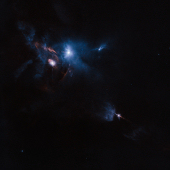ESA Science & Technology - News Archive
News archive
News archive
Despite earlier reports of a possible detection, a joint analysis of data from ESA's Planck satellite and the ground-based BICEP2 and Keck Array experiments has found no conclusive evidence of primordial gravitational waves.
Published: 30 January 2015
The NASA/ESA Hubble Space Telescope has captured this striking view of spiral galaxy NGC 7714. This galaxy has drifted too close to another nearby galaxy and the dramatic interaction has twisted its spiral arms out of shape, dragged streams of material out into space, and triggered bright bursts of star formation.
Published: 29 January 2015
NASA, ESA and The Space Telescope Science Institute (STScI) are pleased to announce the Cycle 23 Call for Proposals for Hubble Space Telescope (HST) observations and funding for archival research and theoretical research programmes. Proposal deadline: 10 April 2015
Published: 23 January 2015
The Space Telescope Science Institute (STScI) is soliciting brief white papers from the community describing initiatives that will significantly enhance what Hubble's scientific legacy will gain from the next five years of observations. These papers, which must have a length of no more than three pages, can address any aspect of the Hubble...
Published: 23 January 2015
Since 2002, ESA's Integral spacecraft has been observing some of the most violent events in the Universe, including gamma-ray bursts and black holes. While it still has years of life ahead, its fuel will certainly run out one day.
Published: 23 January 2015
On 24 April 2015 the NASA/ESA Hubble Space Telescope will celebrate 25 years since its launch and new web pages on the ESA/Hubble website let you know how you can get involved.
Published: 15 January 2015
The NASA/ESA Hubble Space Telescope has captured the sharpest and biggest image ever taken of the Andromeda galaxy - otherwise known as Messier 31. The enormous image is the biggest Hubble image ever released and shows over 100 million stars and thousands of star clusters embedded in a section of the galaxy's pancake-shaped disc stretching...
Published: 5 January 2015
The NASA/ESA Hubble Space Telescope has captured many breathtaking images of the Universe, but one snapshot stands out from the rest: the Eagle Nebula's Pillars of Creation.
Published: 5 January 2015
First impressions can be deceptive - astronomers have used ESA's X-ray satellite XMM-Newton to find a massive black hole hungrily feeding within a tiny dwarf galaxy, despite there being no hint of this black hole from optical observations.
Published: 19 December 2014
Astronomers using ESA's Herschel space observatory have found, for the first time, fireworks of star birth within galaxies at the dense core of a massive early Universe galaxy cluster. This frenzy of star formation reveals the young lives of now "red and dead" elliptical galaxies and gives new clues to the evolution of some of the largest...
Published: 18 December 2014
The Planck Collaboration will present the latest scientific results from ESA’s Planck satellite during a conference to be held from 1 to 5 December 2014 in Ferrara, Italy.
Published: 28 November 2014
Thanks to the NASA/ESA Hubble Space Telescope, some of the most mysterious cosmic residents have just become even more puzzling.
Published: 20 November 2014
The NASA/ESA Hubble Space Telescope has snapped a striking view of a multiple star system called XZ Tauri, its neighbour HL Tauri, and several nearby young stellar objects. XZ Tauri is blowing a hot bubble of gas into the surrounding space, which is filled with bright and beautiful clumps that are emitting strong winds and jets.
Published: 6 November 2014
Using the NASA/ESA Hubble Space Telescope astronomers have made what may be the most reliable distance measurement yet of an object that existed in the Universe's formative years.
Published: 16 October 2014
A team of scientists using the NASA/ESA Hubble Space Telescope have made the most detailed map ever of the temperature of an exoplanet's atmosphere, and traced the amount of water it contains. The planet targeted for both of the investigations was the hot-Jupiter exoplanet WASP-43b.
Published: 9 October 2014
The "PLATO 2.0 Science Conference" will be held in Taormina, Italy, on 3-5 December, 2014. It will bring together experts already involved or willing to collaborate to the preparation of the mission to share ideas and to highlight the potential contribution of PLATO 2.0 to (exo-)planetology in the next decades.
Published: 26 September 2014
Astronomers usually have to peer very far into the distance to see back in time, and view the Universe as it was when it was young. This new NASA/ESA Hubble Space Telescope image of galaxy DDO 68, otherwise known as UGC 5340, was thought to offer an exception.
Published: 25 September 2014
Astronomers using data from the NASA/ESA Hubble Space Telescope, the Spitzer Space Telescope, and the Kepler Space Telescope have discovered clear skies and steamy water vapour on a planet outside our Solar System.
Published: 24 September 2014
The Characterising ExOPlanet Satellite (CHEOPS) is a small mission in the ESA Science Programme. Proposals are solicited for membership in the CHEOPS Science Team. Scientists from institutions located in ESA Member States are invited to apply. The deadline for receipt of applications is 22 October 2014 (12:00 noon CEST).
Published: 19 September 2014
Astronomers using the NASA/ESA Hubble Space Telescope have found a monster lurking in a very unlikely place. New observations of the ultracompact dwarf galaxy M60-UCD1 have revealed a supermassive black hole at its heart, making this tiny galaxy the smallest ever found to host a supermassive black hole.
Published: 17 September 2014
—
20 Items per Page




















